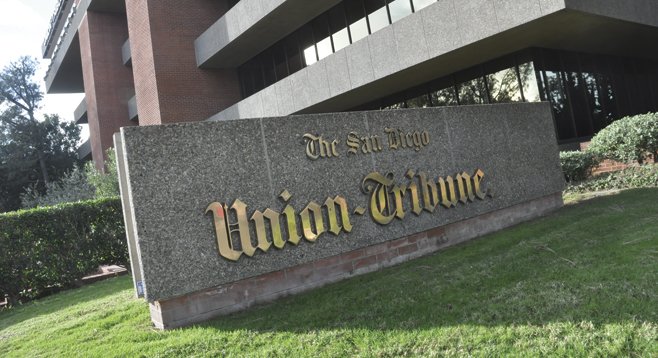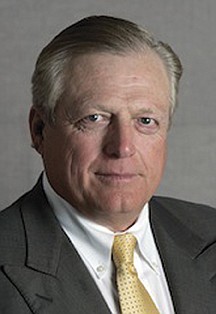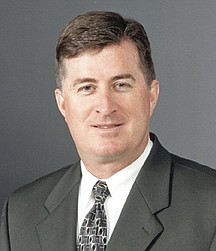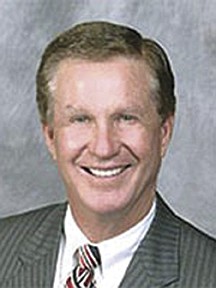 Facebook
Facebook
 X
X
 Instagram
Instagram
 TikTok
TikTok
 Youtube
Youtube

U-T San Diego is propagandizing for an entertainment center at the site of the Tenth Avenue Marine Terminal. A subsidized waterfront football stadium would be located there. The battle over the newspaper’s ludicrous proposal is already providing entertainment, bordering on high comedy. The paper’s chief executive called the Unified Port of San Diego, which disagrees with the paper’s self-proclaimed vision, “one of the greatest scandals of our lifetime.” Pressuring and interfering with writers, he uses his organ to horsewhip the port.

The risk, however, is that U.S. media will once again find San Diego’s buffoonery entertaining. Publications such as the New York Times have already commented on the extreme right-wing, blindly pro-business, pro-military bias throughout the paper under owner “Papa Doug” Manchester and chief executive John Lynch.

“We already are the laughingstock,” says Steve Erie, political science professor at the University of California San Diego and director of the urban studies program. “Manchester and Lynch and their pathetic excuse for a paper are a joke and an embarrassment.”

A close friend of Erie describes San Diego as a “city of toadies and thugs.” The thugs use intimidation tactics to get subsidies for their downtown corporate-welfare schemes, and the toadies, including local politicians, slink along. “The idea of a football stadium at that terminal is felony dumb,” says Erie, noting that ports “have an enormous economic impact.” The multiplier effect, or the phenomenon of some economic activity starting a chain reaction generating more activity, is potent with ports. “They generate good jobs.”

And that’s the critical argument: middle-class jobs. San Diego’s economy, like the nation’s, is suffering from a withering middle class. Consumer spending is more than 70 percent of the economy, but the flattening of worker incomes — combined with the stark rise of higher incomes — has created an economy that is out of whack. The rich have entirely too much spending power, and the rest of the people have too little.

Supposedly, an entertainment district at the Tenth Avenue Marine Terminal will create jobs. Nonsense. Objective economists say there is little or no multiplier effect with sports stadiums. Workers at the football facility would simply move over from Qualcomm Stadium. Moreover, “these are low-paying jobs, only part-time,” says Kelly Cunningham, economist for the National University System Institute for Policy Research. An entertainment district might create a few restaurant, bar, and lodging jobs, but by eliminating that port location, San Diego “would be trading fairly good-paying jobs for low-paying jobs.”
I got current San Diego wage data from the California Employment Development Department. Here are some average annual wages in the bar and restaurant business: restaurant cooks, $25,698; dishwashers, $19,549; restaurant hosts and hostesses, $19,742; fast-food cooks, $20,253; waiters and waitresses, $20,063; and bartenders, $21,268. Tips can boost the incomes of some, but these are low earnings, and benefits are low or nonexistent.
And look at some annual remuneration in the lodging business: bellhops, $22,591; hotel and motel clerks, $24,287; and concierges, $28,140. Even managers of lodging establishments only average $56,248.
The average annual wage in San Diego County is $51,051. Generally, employees in the leisure and hospitality business are fortunate if they earn half the county average.
But consider the wages of port employees, as revealed on the port’s website. A maintenance mechanic makes $56,659 to $75,920 a year; a wharf operator, $58,344 to $78,187; a custodian, $32,968 to $44,179; and a maintenance worker, $37,981 to $50,898. Seven years ago, the average port salary was more than $59,000 a year. Benefits are generous.
Says Corinne Wilson, research and policy lead for the Center on Policy Initiatives, “We need a good mixture of industries in the region, and we have an overabundance of jobs in the tourism industry. That is shortsighted for many reasons: one is that the pay rates in the industry bring down the average for the entire region, and when there are economic downturns, it is not wise to have all your eggs in one basket.” She would like to see government-imposed wage and benefit standards for certain low-paying industries.
In San Diego County, 13.5 percent of jobs are in the low-paying leisure and hospitality industries; nationally, the figure is 10.5 percent.
Port detractors point out that business is declining and the facility is wee by comparison with those in Los Angeles and Long Beach. True, but there is a painfully slow recovery from a deep recession. Cunningham notes that the Tenth Avenue terminal is a rare deepwater facility that has a niche market for such things as bananas and cement.
There is talk that the U-T-touted entertainment area might generate hotel construction. But, as Jerry Morrison, La Jolla–based hotel consultant, points out, sports stadiums do not bring significant business to hotels, except at special events such as the Super Bowl.
Tourism has definitely picked up the past couple of years. Two years ago, Morrison was saying that any San Diego hotel built or refinanced in the previous five years was underwater. Although San Diego tourism has recovered, this year’s levels are not back to those of pre-recession 2007, says Morrison. The occupancy rate, revenue per available room, and average daily room rate thus far this year are all down from the same period five years ago. San Diego lags San Francisco, Anaheim, and Los Angeles in the recovery, and Morrison doesn’t know why. “Our demand just isn’t as high as some other places in California,” he says.
But the convention center expansion pushes on despite the stark overbuilding of American convention facilities, a drop-off of convention attendance, and the center’s widely recognized, deliberate bloating of its performance statistics. U-T San Diego plays the bully in its attempt to get a football stadium at a site now used as a port. The newspaper’s beloved mayoral candidate, Carl DeMaio, insists he does not favor the idea. But, says Norma Damashek, former president of the League of Women Voters, “We have a lot of liars around here.” ■


U-T San Diego is propagandizing for an entertainment center at the site of the Tenth Avenue Marine Terminal. A subsidized waterfront football stadium would be located there. The battle over the newspaper’s ludicrous proposal is already providing entertainment, bordering on high comedy. The paper’s chief executive called the Unified Port of San Diego, which disagrees with the paper’s self-proclaimed vision, “one of the greatest scandals of our lifetime.” Pressuring and interfering with writers, he uses his organ to horsewhip the port.

The risk, however, is that U.S. media will once again find San Diego’s buffoonery entertaining. Publications such as the New York Times have already commented on the extreme right-wing, blindly pro-business, pro-military bias throughout the paper under owner “Papa Doug” Manchester and chief executive John Lynch.

“We already are the laughingstock,” says Steve Erie, political science professor at the University of California San Diego and director of the urban studies program. “Manchester and Lynch and their pathetic excuse for a paper are a joke and an embarrassment.”

A close friend of Erie describes San Diego as a “city of toadies and thugs.” The thugs use intimidation tactics to get subsidies for their downtown corporate-welfare schemes, and the toadies, including local politicians, slink along. “The idea of a football stadium at that terminal is felony dumb,” says Erie, noting that ports “have an enormous economic impact.” The multiplier effect, or the phenomenon of some economic activity starting a chain reaction generating more activity, is potent with ports. “They generate good jobs.”

And that’s the critical argument: middle-class jobs. San Diego’s economy, like the nation’s, is suffering from a withering middle class. Consumer spending is more than 70 percent of the economy, but the flattening of worker incomes — combined with the stark rise of higher incomes — has created an economy that is out of whack. The rich have entirely too much spending power, and the rest of the people have too little.

Supposedly, an entertainment district at the Tenth Avenue Marine Terminal will create jobs. Nonsense. Objective economists say there is little or no multiplier effect with sports stadiums. Workers at the football facility would simply move over from Qualcomm Stadium. Moreover, “these are low-paying jobs, only part-time,” says Kelly Cunningham, economist for the National University System Institute for Policy Research. An entertainment district might create a few restaurant, bar, and lodging jobs, but by eliminating that port location, San Diego “would be trading fairly good-paying jobs for low-paying jobs.”
I got current San Diego wage data from the California Employment Development Department. Here are some average annual wages in the bar and restaurant business: restaurant cooks, $25,698; dishwashers, $19,549; restaurant hosts and hostesses, $19,742; fast-food cooks, $20,253; waiters and waitresses, $20,063; and bartenders, $21,268. Tips can boost the incomes of some, but these are low earnings, and benefits are low or nonexistent.
And look at some annual remuneration in the lodging business: bellhops, $22,591; hotel and motel clerks, $24,287; and concierges, $28,140. Even managers of lodging establishments only average $56,248.
The average annual wage in San Diego County is $51,051. Generally, employees in the leisure and hospitality business are fortunate if they earn half the county average.
But consider the wages of port employees, as revealed on the port’s website. A maintenance mechanic makes $56,659 to $75,920 a year; a wharf operator, $58,344 to $78,187; a custodian, $32,968 to $44,179; and a maintenance worker, $37,981 to $50,898. Seven years ago, the average port salary was more than $59,000 a year. Benefits are generous.
Says Corinne Wilson, research and policy lead for the Center on Policy Initiatives, “We need a good mixture of industries in the region, and we have an overabundance of jobs in the tourism industry. That is shortsighted for many reasons: one is that the pay rates in the industry bring down the average for the entire region, and when there are economic downturns, it is not wise to have all your eggs in one basket.” She would like to see government-imposed wage and benefit standards for certain low-paying industries.
In San Diego County, 13.5 percent of jobs are in the low-paying leisure and hospitality industries; nationally, the figure is 10.5 percent.
Port detractors point out that business is declining and the facility is wee by comparison with those in Los Angeles and Long Beach. True, but there is a painfully slow recovery from a deep recession. Cunningham notes that the Tenth Avenue terminal is a rare deepwater facility that has a niche market for such things as bananas and cement.
There is talk that the U-T-touted entertainment area might generate hotel construction. But, as Jerry Morrison, La Jolla–based hotel consultant, points out, sports stadiums do not bring significant business to hotels, except at special events such as the Super Bowl.
Tourism has definitely picked up the past couple of years. Two years ago, Morrison was saying that any San Diego hotel built or refinanced in the previous five years was underwater. Although San Diego tourism has recovered, this year’s levels are not back to those of pre-recession 2007, says Morrison. The occupancy rate, revenue per available room, and average daily room rate thus far this year are all down from the same period five years ago. San Diego lags San Francisco, Anaheim, and Los Angeles in the recovery, and Morrison doesn’t know why. “Our demand just isn’t as high as some other places in California,” he says.
But the convention center expansion pushes on despite the stark overbuilding of American convention facilities, a drop-off of convention attendance, and the center’s widely recognized, deliberate bloating of its performance statistics. U-T San Diego plays the bully in its attempt to get a football stadium at a site now used as a port. The newspaper’s beloved mayoral candidate, Carl DeMaio, insists he does not favor the idea. But, says Norma Damashek, former president of the League of Women Voters, “We have a lot of liars around here.” ■
Comments